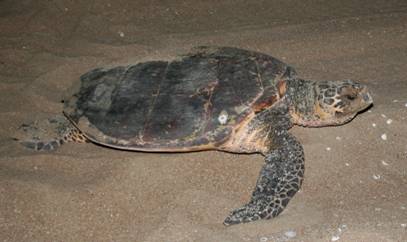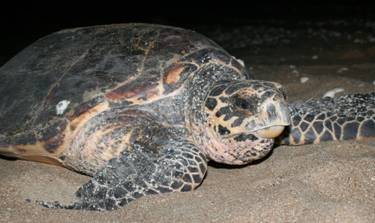Hawksbill turtle

Common name: hawksbill turtle
Scientific name: Eretmochelys imbricata
Family: Cheloniidae
Description
The hawksbill turtle is olive-green or brown above, richly variegated with reddish-brown, dark brown and black. The scales of head and face are often dark with pale contrasting sutures (lines between the scales) and it is cream to yellowish below (the plastron). Hawksbill turtle hatchlings are a brown-black colour. There are four costal scales on each side of the shell (refer to the Marine Turtle Field Guide ). The adult females' average carapace (shell) length is 82cm and weight is 50kg. The hawksbill turtle has a distinctive parrot-like beak.
Habitat and distribution
The hawksbill turtle forages over coral reefs, rock outcroppings, and seagrass beds. In Australia the hawksbill turtle is found along the tropical coasts of northern and eastern Australia, from mid-western Western Australia to southern Queensland. The main feeding area extends along the east coast, including the Great Barrier Reef. Other feeding areas include Torres Strait and the archipelagos of the Northern Territory and Western Australia, possibly as far south as Shark Bay or beyond.
Australia has some of the largest remaining nesting populations of hawksbill turtles. In 2000, nesting in north Queensland and the Torres Strait was estimated to be approximately 4,000 females, and in eastern Arnhem Land approximately 2,500 nesting females. The Western Australia hawksbill turtle stock is one of the largest in the world with most of the nesting located in the Pilbara including approximately 1,000 nesting females per year at Rosemary Island.
Monitoring of the northern Queensland hawksbill turtles at Millman Island indicates declining nesting populations however it is unknown whether this trend is representative.
Life history and behaviour
Hawksbill turtles have a sharp pointy beak that they use to pick sponges out of cracks and crevices in coral reefs. They mature slowly and may not reach reproductive age until 30 years. Females lay between one to six clutches per season with an average of 122 eggs. Females will only nest every two to four years. After the hatchlings emerge from the nest they swim for several days out into the sea. They then spend approximately five to 10 years drifting in the ocean and return to the coastal areas of Australia at about 38cm long.
Diet: The majority of their diet consists of sponges, although they also feed on seagrasses, algae, soft corals and shellfish.

Threatening processes
All marine turtle species are experiencing serious threats to their survival. The main threats to the hawksbill turtle are climate change, marine debris-entanglement, international take and terrestrial predation. Other threats include light pollution and indigenous harvesting of eggs.
The hawksbill turtle is prized for the scales of its carapace (shell). All around the world jewellery and ornaments have been made out of ‘tortoiseshell’. For this reason hawksbill turtles have almost been hunted to extinction in many countries. Trade of tortoiseshell is now banned internationally, however some illegal trade still occurs. Some Australian nesting and feeding populations may be threatened by harvest for meat and the tortoiseshell trade in neighbouring countries, particularly Papua New Guinea and the Solomon Islands.
Recovery actions
A national Recovery Plan for Marine Turtles in Australia exists and identifies the management actions necessary to recover marine turtle species in Australia.
To conserve current populations it is imperative that major existing feeding and nesting sites are protected. The control of feral pigs, foxes and wild dogs is essential at nesting sites along Queensland's coast to protect eggs from predation. Fishing activities also need to be monitored, in particular the use of Turtle Excluder Devices (TEDs) and the need for commercial fishers to check longlines, gillnets and lobster/crab pots frequently to disentangle any turtles caught accidentally.
How you can help
You can help this species by:
- Report sick, injured, dead and/or tagged marine turtles to 1300 130 372. A Queensland Government officer in the relevant region will be contacted with your information and will determine the appropriate response.
- Remember that rubbish you throw away can find its way to the sea, where turtles can mistake things such as plastic bags for jellyfish. Plastic swallowed by mistake can cause blockages of the stomach and intestines of marine animals such as turtles.
- Follow the regulations relating to "go slow areas for turtles and dugong" including operating vessels off the plane and not undertaking motorised water sports. Many turtles are struck by propellers of speeding boats and this can cause injury and death.
- Be careful not to damage seagrass by careless anchoring or operating of a vessel in shallow water where boat wash or propeller damage can occur.
- Take care when fishing. Don't leave behind discarded fishing lines and don't use stainless steel hooks.
- Check crab pots regularly. Set your pots to avoid loose rope floating about in the water and ensure your pot entrances are not large enough to trap a turtle. Familiarise yourself with the guidelines on how to make a new crab pot, or learn how to correctly modify an existing one
- If you live adjacent to beaches in south Queensland, join your local Community Turtle Monitoring group and assist in protection and monitoring of turtle nests.
Further information
- Boat strike impact on turtle and dugong in Moreton Bay
- Carpentaria Ghost Nets Programme
- Department of the Environment and Energy (DOEE) 2017. Eretmochelys imbricata, hawskbill turtle: in Species Profile and Threats Database. DOEE Canberra.
- Environment Australia and Marine Turtle Recovery Team 2003. Recovery plan for marine turtles in Australia. Department of the Environment and Heritage, Canberra.
- Queensland Parks and Wildlife Service 2016. Queensland Marine Turtle Field Guide . Department of National Parks, Sport and Racing, Brisbane.
- Spotila, JR 2004. Sea turtles. The John Hopkins University Press, London.


